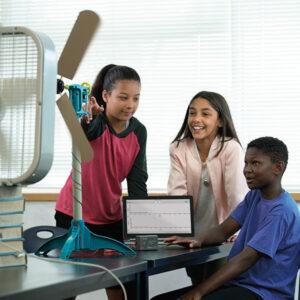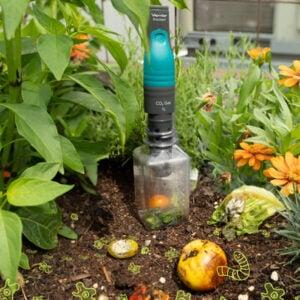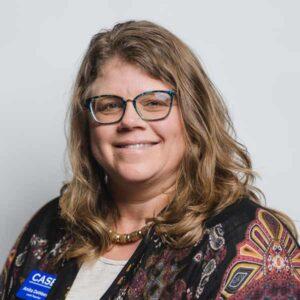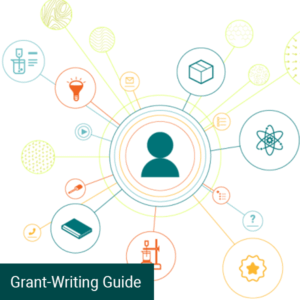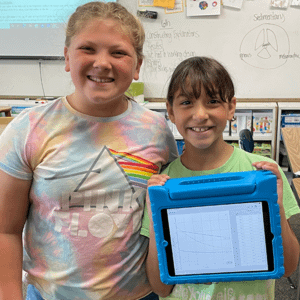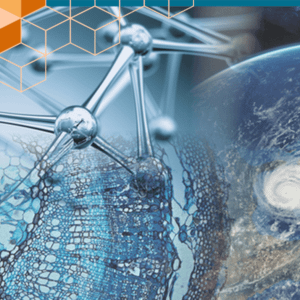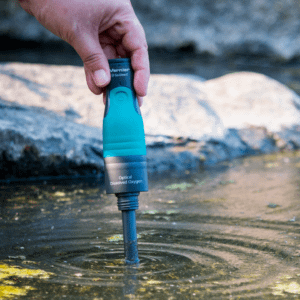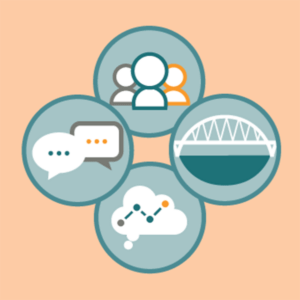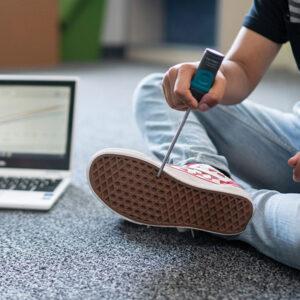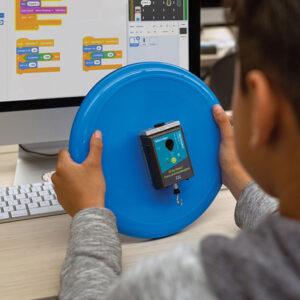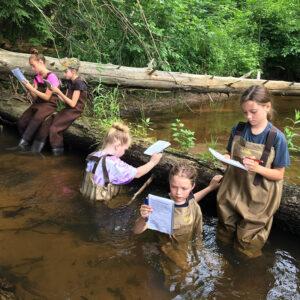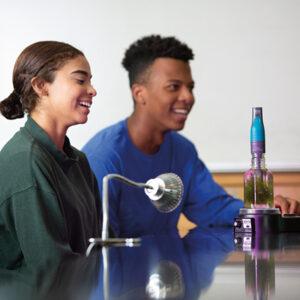
Sharing ideas and inspiration for engagement, inclusion, and excellence in STEM
Our Top Blog Posts of 2025
2025 has been a year of momentum and meaningful progress. We grew our Trendsetters Community, launched remote logging for Go Direct® sensors, and added new sensors to our lineup. We also continued modernizing our suite of analysis apps to give educators more flexible, future-ready tools and supported classrooms through ongoing initiatives like our Inspiration Grants.
3 Hands-On Experiments Using the Go Direct Force and Acceleration Sensor
From everyday activities like opening a door or riding a bike to more complex applications like designing safer cars or propelling rockets into space, force impacts countless aspects of our daily lives. Yet, for many students, force remains an abstract concept—there is nothing for them to “see” or “touch.”
Five Ways to Make the Most of Your District’s STEM Budget
Are you planning on making new STEM investments this year or looking for ways to get more from the STEM technology you already have? Vernier’s newest guide, Maximizing STEM Impact with Strategic Investments: A Practical Guide for Budget-Conscious Districts, offers a step‑by‑step framework for district leaders seeking to improve science instruction.
3 Hands-On, Low-Prep Sensor Activities to Start the School Year
The first week of school is a great time to lean into student curiosity, help everyone get comfortable with your lab routines and tools, and build students’ confidence with Vernier sensors and software. Whether you teach middle school science, high school science, or introductory college courses, the goal is the same: Empower students to use real-time data to make sense of the world.
Empowering Teachers, Engaging Students: A New Era of STEM Learning with Vernier Connections Powered by Penda
For over 40 years, Vernier Science Education has been a trusted leader in hands‑on STEM education, equipping educators with the tools and technology to bring real-world data collection and analysis into the classroom. Penda Learning has developed a digital learning platform grounded in cognitive science‑using gamification and research‑based strategies to keep students motivated while boosting engagement and achievement in standards‑based science instruction.
Stories That Stick: Ideas for Integrating Science and Language Arts
Whether it’s through science fiction novels, engaging literary nonfiction, or comics, educators are finding creative ways to bring literacy into STEM learning. These approaches echo the research‑backed connections between Common Core literacy standards and the NGSS Science and Engineering Practices, particularly in the areas of argumentation, communication, and evidence‑based reasoning.
Getting Started with Green Chemistry
At Beyond Benign, we believe chemistry education can be a powerful force for good. Green chemistry offers educators a practical way to teach core science concepts while prioritizing human health, environmental responsibility, and innovation. In this blog post, we’ll explore what green chemistry is, why it matters, and how educators at both the K–12 and university/college (Higher Ed) levels can get started integrating it into their teaching.
7 Go Direct® Temperature Probe Ideas from Elementary to Advanced
With more than 150 experiments in our lab books that use the Go Direct® Temperature Probe, it’s no exaggeration to say this sensor is one of the most versatile tools in any science classroom.
Four 3D-Aligned Experiments for Your Middle School Classroom
Middle school is a great time to give students more experience collecting and working with data. Whether they’re testing chemical reactions, tracking environmental changes, or exploring energy systems, hands-on investigations help them connect big science ideas to the world around them.
From Seafloors to Salinity: 3 Hands-On Investigations into Ocean Science Phenomena
Covering more than 70% of Earth’s surface, the ocean plays a vital role in our planet’s climate, ecosystems, and everyday life. World Ocean Day (June 8) and World Ocean Month offer timely opportunities to explore this dynamic system through interdisciplinary learning that connects chemistry, biology, Earth science.
5 Key Tools in Vernier Video Analysis—And How to Use Them
Vernier Video Analysis® helps students explore motion through real-world video, giving them a hands-on way to connect graphical representations of data with the movement they actually see. Whether you're just getting started or looking for a refresher, this post walks you through five key tools in the app—along with tips on when and why to use each one.
Investigating Solar Energy: Which Variables Optimize Power Output?
Every April, Earth Day offers a timely opportunity to explore how science and engineering intersect with the real world. This year’s theme, Our Power, Our Planet, invites students to consider the role of energy in shaping the future—and how we can use real-world data, engineering design, and problem-solving to explore cleaner, more sustainable options.
In the hands-on investigation outlined here, students use Vernier technology to explore which variables affect solar panel output. With tools like the Go Direct® Energy Sensor and KidWind solar panels, they’ll test and analyze real-time data to determine how design decisions influence performance. Along the way, they’ll build key skills in problem-solving, systems thinking, and evidence-based decision-making—all essential elements of the engineering design process and three-dimensional learning.Everything You Need to Know About the Logger Pro Transition
For more than 20 years, Logger Pro™ has been a trusted tool for educators helping students explore real-world data in real time. To our long-time Logger Pro users, thank you for making this application a cornerstone of your classrooms. We’re proud of its legacy and excited to share this next chapter of data analysis with you.
From Summer Science Camps to Teacher Training: Dr. Ann Nalley Shares Why Vernier Technology Is the Future of STEM Education
Dr. Ann Nalley, a chemistry professor at Cameron University in Oklahoma and former president of the American Chemical Society (ACS), has dedicated her career to empowering both students and teachers through hands-on science education. With more than 50 years of experience teaching freshman and organic chemistry, leading summer academies for K–12 students, and training teachers at the university and through workshops, she has become a passionate advocate for integrating Vernier technology into classrooms and labs.
Three Mechanics Investigations with the Go Direct Motion Detector
There are many ways to measure motion in your physics classes, from the classic meter stick and stopwatch method to photogates and sensor carts. But the Go Direct® Motion Detector is one of the most versatile, engaging tools you can leverage in your classroom. This sensor measures the position of moving objects by sending out an ultrasonic pulse (a sound wave at a frequency beyond human hearing) and using the echo from its target to calculate velocity and acceleration data.
Why Isn’t There Dead Stuff Everywhere?! Exploring the Nature of Decomposition with a CO2 Gas Investigation
All species in an ecosystem, from critters on the forest floor to lions in the Serengeti, are directly or indirectly nourished by “dead stuff.” This organic matter, whether fallen leaves, rotting fruit, or decomposing organisms, is a crucial part of the continuous cycle of matter and energy flow in an ecosystem. While much attention is usually given to producers and consumers, an often ignored part of the food web—decomposers—play an equally vital role. These organisms break down dead matter, releasing carbon (in the form of carbon dioxide) and other nutrients back into the environment. With the Go Direct® CO2 Gas Sensor, students can observe this process in real-time, gaining a deeper understanding of the carbon cycle and the importance of decomposition.
How to Introduce Your Students to Data-Collection Basics
Whether studying CO2 changes during photosynthesis or investigating the conservation of momentum during a collision, students need to be able to do more than just plot points on a graph—they need to understand the story that a graph tells. One incredibly effective way to develop this kind of data literacy is to incorporate data-collection technology and investigations into your instruction. Real-time data collection not only helps students build stronger connections between abstract scientific concepts and the real world but also helps students transform raw data into meaningful insights through tabulation, graphs, visualization, and statistical analysis.
Choosing the Right pH Sensor for Your Classroom or Lab
From testing household acids and bases to evaluating soil and water quality for agriculture, measuring and interpreting pH data is an essential skill across scientific disciplines and education levels. Our pH sensors all offer similar accuracy, response time, and sensitivity. So, which one should you buy? It depends on how and where you plan to use your pH sensor. Follow these guidelines to help you choose the right tool for your specific lab or classroom needs.
Successful Implementation of Probeware in Schools: Research-Based Tips and Guidelines
When schools adopt new technologies, effective implementation is crucial for success. This is particularly true for technology that is adopted specifically as an effort to support or expand teaching aligned with new standards. Based on the findings of our recent white paper, here are some essential tips and best practices to ensure successful integration and maximize the benefits of new technology in the classroom.
Engaging Students with Summer Learning Activities: Data Collection in the Field
Looking for ideas to take learning outside this summer? Whether you’re involved in education through schools, museums, non-profits, or community programs, engaging learners of all ages in natural settings offers immense benefits, from K–12 through college. Plus, it’s fun! Not just for students, but for educators and program leaders, too. You’ll get to see how students interact with each other in a different location, expose them to authentic natural phenomena, and encourage their scientific curiosity in a grounded, real-world context. Whether you’re planning a summer field trip or exploring nearby natural areas with a scientific eye, here are some ideas and tips to get you started with data collection in the field.
Five Trailblazing Female Asian American & Pacific Islander Scientists with Impactful STEM Legacies
May is National Asian American and Pacific Islander Heritage Month, an excellent time to help your students learn about the pivotal contributions Asian Americans, Native Hawaiians, and Pacific Islanders have made to the STEM fields—and continue to make today! As we celebrate their accomplishments, it’s also important to acknowledge the gaps in visibility within these groups, particularly among AAPI women in science. For example, recent studies have shown women in this demographic are notably less likely to be employed in leadership positions in STEM, even when highly educated. This discrepancy also persists in educational resources, where textbooks continue to underrepresent women and people of color in STEM. To help spotlight their considerable academic and scientific research contributions, here are five influential AAPI women whose stories and achievements you can share with your students, as well as a few experiment ideas to connect with their research.
Connecting Students to the Natural World through Service and Place-Based Learning in Their Own Backyard
After 30 years of teaching science at East Palestine Schools in Ohio, Dr. Lisa Bircher is confident about one thing: students deserve to be involved in experiences that expand beyond the classroom. Whether that’s monitoring water quality in local streams and lakes with probeware or simply sorting through recyclables in the outdoor area behind the school property, students learn best when they are actively engaged in real-world, hands-on learning opportunities.
Bircher earned the 2023 NABT Ecology/Environmental Science Teaching Award, sponsored by Vernier Science Education, and recently made the transition into retirement. As part of her plans for the future, Bircher is exploring going into ministry, laughing, “It’s a lot like teaching, honestly. I just don't have the really cool lab equipment.”Introducing Jill Hedrick: A Q&A with the New CEO of Vernier Science Education
Vernier Science Education is proud to introduce our new CEO, Jill Hedrick! Jill is a passionate leader focused on the intersection of technology and social impact. Joining Vernier shortly after our transition to a Perpetual Purpose Trust, Jill’s wealth of leadership experience and knowledge will help anchor the company in our core mission and values.
Five Ways Teaching Science with Probeware Promotes 3D Learning
Are you looking for effective ways to integrate three-dimensional learning into your science classroom? Our most recent white paper, Exploring the Data: A Comprehensive Review of Research on Probeware and Three-Dimensional Teaching, explores the latest research that highlights how probeware supports active, student-driven learning.
Probeware can play a pivotal role in creating opportunities for students to make sense of phenomena in the ways envisioned by the Next Generation Science Standards (NGSS) and standards aligned to A Framework for K–12 Science Education. Here are five ways probeware, such as Vernier sensors, supports the 3D learning framework.An Experiment to Help Students Understand Ocean Acidification through pH
Today’s environmental challenges call for ongoing discussions and hands-on learning opportunities to deepen student understanding and engagement in environmental stewardship. One such activity is to investigate how the burning of fossil fuels not only contributes to climate change, but also leads to changes in environmental chemistry, such as the increase in ocean acidification and subsequent increase in acid rain.
Ready, Set, Science! Get Your Science Game On with These Four Sports‑Themed Experiments
We had such a blast at NSTA Denver 2024 last week! One of our big highlights this year was getting to mix science and sports with fun, athletics-inspired activities. Below we’re sharing four of our favorite sports-themed experiments you can try out to elevate your classroom game!
Exploring the Antarctic with Vernier: A Physics Teacher's Expedition to Inspire Classroom Science
The Grosvenor Teacher Fellowship (GTF) is an experiential professional development opportunity offered through the National Geographic Society and Lindblad Expeditions. This program sends teachers out on expeditions to remote locations to inspire them to inspire their students.
Two Hands-On Motion Investigations with the New Go Direct® Force Plate
Engaging students in physics can be as simple as getting them moving! The Go Direct® Force Plate, our newest physics sensor, invites students to explore the principles of motion through their own actions like jumping, stepping, and pushing. Equipped with wireless capabilities and brand new channels including Hang Time for physics classes, and Jump Height and X- and Y-axis Balance for physiology classes, the Force Plate opens up new avenues for creativity and exploration in the classroom. In this blog post, we are sharing two investigations we recommend to help explore physics fundamentals using the Go Direct Force Plate.
7 Tips and Ideas to Make the Eclipse Engaging for Your Students
On April 8, 2024, a total solar eclipse will be visible over the United States, starting in Texas. This upcoming eclipse event is an exciting opportunity to incorporate phenomenon-based learning into your instruction and engage your students through inquiry.
Eclipse Extravaganza: Bringing Celestial Science to Life for Local and K–12 Communities in Mississippi
It seems like all the celestial bodies were in alignment on Saturday, October 14, 2023, in Oxford, Mississippi, just in time for the much-anticipated annular solar eclipse. Christian Clark, a graduate research fellow at the Center for Math and Science Education (CMSE) at the University of Mississippi and one of the organizers of the Eclipse Extravaganza event, reflects on their good luck.
KidWind Challenges: Engaging Students in Real-World Applications of Renewable Wind Energy
In an era where renewable energy plays a major role in a sustainable future, educational initiatives like KidWind Challenges are increasingly relevant. These practical design challenges get students involved in meaningful conversations about renewable energy through the exploration of wind and solar power. In teams, middle and high school students globally engage in designing, building, and testing small-scale wind turbines and solar structures, deepening their understanding and investment in renewable energy.
The Farm-to-Classroom Experience: CASE-Awardee Anita DeWeese Makes Big Impacts in Ag Engagement and Assessment
Bottle feeding baby lambs isn’t an everyday experience for most students in Anita DeWeese’s class at Skyline Schools in Kansas state. But thanks to her family farm, it’s one of the unique experiences DeWeese is able to bring to her agricultural science classroom to help bridge the gap between academic curriculum and the realities of farm life.
TI Graphing Calculators + Vernier Go Direct® Sensors = A Match Made in STEM!
What do science students get when teachers connect Vernier Go Direct® sensors with TI’s Python-capable graphing calculators? An easy-to-use, portable and wireless data collection system that gets them more engaged in their learning!
Smashing Squash and Regurgitating Gourds: Eerie Experiments for Your Physics and Chemistry Classes
As we officially move into autumn and begin creeping closer to the spookiest season of the year, it’s the perfect time to add a little bit of pumpkin spice to your science curriculum.
Two Amazing Solar Eclipses in the Upcoming School Year
Celestial excitement is on the horizon as we have not one, but two, solar eclipses to look forward to this school year. On October 14, we'll be treated to an annular solar eclipse, which will be visible over the United States, starting in Oregon. Then, mark your calendars for April 8, 2024, when a total solar eclipse will be visible over the United States, starting in Texas.
Exploring Magnetic Fields: Three Hands-On Experiments with the Go Direct 3-Axis Magnetic Field Sensor
Looking for fresh ways to engage your students in the study of magnetic fields? Guide your students through the invisible forces that influence our world with the Go Direct 3-Axis Magnetic Field Sensor.
Five Essential Steps to Get Your Lab Ready for the New School Year
Is your STEM lab fully prepared for classes this fall? Taking the time to assess your equipment at the start of the year can prevent future headaches and mitigate expenses down the road. Ensure your lab is science experiment-ready and in optimal working condition with this simple checklist.
Back-to-School Experiments to Kick-Start Your School Year
As we gear up to welcome students back to the classroom, it’s the perfect time to strategically introduce (or reintroduce) the fundamental principles of data collection. No matter the subject, understanding how to collect, analyze, and interpret data is not only key to fostering good inquiry, it’s also a fun way to spark engagement in students as they come back to class from summer break.
We’re sharing our favorite back-to-school science experiments that use some of our most popular sensors, including the Go Direct® Temperature Probe, the Go Direct Conductivity Probe, and the Go Direct Motion Detector. Give these a try to get your students moving, mixing, measuring, and observing in the classroom this fall!Three Tips to Help You Get the Most Out of the Go Direct Motion Detector
One of the most versatile ways for students to measure motion—a key scientific concept—is the
Go Direct® Motion Detector.Harnessing the Power of Solar Energy Exploration with KidWind
Looking for a way to explore solar energy in your class—and promote hands-on science learning at the same time? KidWind, our line of renewable energy products, includes solar panels appropriate for teaching students from K–12 to college.
Everything You Need to Know about Summer Sensor Storage
Proper storage over the summer is key to extending the useful life of your laboratory’s sensors. Before you enjoy your well-deserved summer break, it’s a great idea to take stock of your Vernier probeware and make sure it’s correctly stored for the next few months.
Five Common Household Items You Can Use to Teach Your Students Key Chemistry Concepts
It can be challenging for students to wrap their minds around key chemistry concepts, such as pH, Beer’s law, and gas conversions. You can help demystify these abstract scientific ideas with hands-on learning that incorporates common household items.
Six Tips for Getting the Most Out of the Go Direct® Weather System
Want a way to easily monitor a variety of environmental factors with just one sensor? The Go Direct Weather System gives students the tools to measure ambient temperature, humidity, wind chill, dew point, barometric pressure, and more.
Four Experiments to Help Your Students Explore the Science Behind Climate Change
Climate change is a complex, long-term process, so it can be challenging to conduct classroom experiments that show the phenomenon.
Empowering Students and Extending STEM Curriculum with a Classroom Aquarium
In middle school science classes, data-collection technology is a great tool for promoting hands-on learning. This school year, Jeff Branchaud and his students are using an additional tool: a 55-gallon classroom aquarium.
Hands-On Physics Learning with Water Rockets, Mousetrap Race Cars, Bridges, and Wind Turbines
All students benefit when they can apply physics principles and concepts by building something. Having that real-world connection can help make physics easier to understand. As an added bonus, it can also increase student engagement.
Latino STEM Alliance: Sparking Interest in Science Exploration for Underserved Youth with Robotics and Project-Based Learning
Hispanic workers represent just 8 percent of the STEM workforce, according to the Pew Research Center. The Latino STEM Alliance (LSA) seeks to increase that number.
Answers to the Top Five Questions about pH Sensor Care
Whether you teach college chemistry, high school biology, or middle school science, a pH sensor is a great tool to help your students explore the fundamental scientific concept of pH.
Three Steps to Help You Prepare to Write a Successful Grant Proposal to Fund Your STEM Learning Projects
Applying for a grant to fund your STEM education initiatives might feel daunting. However, this process doesn’t have to be overly complicated or time-consuming—and if you’re successful, it can be a huge benefit for your students and your school.
Elevate Hands-On STEM Learning with These K–12 Experiments
Vernier offers more than 1,000 experiments in biology, chemistry, engineering/robotics, and physics that can promote STEM literacy and help you integrate data-collection technology into your classes.
Culturally Responsive STEM Programming: Indigenous Communities and the Oregon Museum of Science and Industry
The Oregon Museum of Science and Industry (OMSI) is dedicated to serving all of Oregon and firmly believes in the importance of culturally responsive STEM education. OMSI is also committed to collaborating with American Indian Tribes and Indigenous communities to co-develop programming that meets their needs and is rooted in their culture and values.
Bring Biology Concepts to Life with the Go Direct® CO₂ and O₂ Gas Sensors
In biology courses, students tend to learn about big-picture concepts that can be difficult to comprehend, such as cellular respiration, photosynthesis, and cellular metabolism.
K–12 Experiments of the Month: Elevate Hands-On STEM Learning
Vernier offers more than 1,000 experiments in biology, chemistry, engineering/robotics, and physics that can promote STEM literacy and help you integrate data-collection technology into your classes.
Getting Students Involved and Invested in Their Own Learning with User-Friendly Vernier Technology: A Q&A with Alexandra Boyd
Alexandra Boyd teaches AP Physics at Apex Friendship High School in Apex, North Carolina. Last year, she won a 40th anniversary educator grant from Vernier, which included $1,000 in Vernier technology. We sat down with Boyd to discuss the impact of the grant on her and her students. The interview has been edited for length and clarity.
Versatile Go Direct® Light and Color Sensor Helps Illuminate Concepts Across the Science Curriculum
Good things come in small packages—including the Go Direct Light and Color Sensor.
Five Research-Based Best Practices for STEM Education
The quest for high-quality STEM education starts with having a solid foundation grounded in research. But what exactly does the research say about high-quality STEM education?
K–12 Experiments of the Month: Elevate Hands-On STEM Learning
Vernier offers more than 1,000 experiments in biology, chemistry, engineering/robotics, and physics that can promote STEM literacy and help you integrate data-collection technology into your classes.
Python® and LabQuest®: Opening Up Opportunities for STEM Educators and Students
When you think about ways to teach science, coding might not be the first thing that comes to mind.
“Be the Spark that Makes All the Difference”: Addressing Barriers to Latino Representation in STEM
The mission of the Society of Hispanic Professional Engineers (SHPE) is to “change lives by empowering the Hispanic community to realize its fullest potential and to impact the world through STEM awareness, access, support, and development.” We recently sat down with the organization’s chief research and innovation officer, Dr. Kimberly Douglas, to discuss the current state of—and actions being taken to increase—Latino representation in STEM. The interview has been edited for length and clarity.
Ramp Up Physics Learning Using Our Dynamics Cart and Track System with the Go Direct® Sensor Cart
Get all the equipment you need to teach dynamics and kinematics using our Dynamics Cart and Track System with the Go Direct Sensor Cart. This wireless system simplifies experiment setup and allows basic physics experiments to be conducted with or without the track.
K–12 Experiments of the Month: Elevate Hands-On STEM Learning
Vernier offers more than 1,000 experiments in biology, chemistry, engineering/robotics, and physics that can promote STEM literacy and help you integrate data-collection technology into your classes.
Standing Out in a Rural District with the Support of Vernier Technology: A Q&A with Amy Hindbaugh-Marr
Amy Hindbaugh-Marr is a science, technology, engineering, arts, and math (STEAM) teacher for students in kindergarten through sixth grade at Ithaca Public Schools in Ithaca, Michigan. Last year, she won a 40th anniversary educator grant from Vernier, which included $1,000 in Vernier technology. We recently sat down with Hindbaugh-Marr to discuss the impact of the grant on her and her students. The interview has been edited for length and clarity.
Sunshine and STEM: The Advantages of Summer Science Learning Programs
Learning doesn’t have to take a vacation over summer break. In fact, school administrators, the US Department of Education, and groups such as the Harvard Family Research Project agree that K–12 students benefit from year-round learning opportunities.
K–12 Experiments of the Month: Elevate Hands-On STEM Learning
Vernier offers more than 1,000 experiments in biology, chemistry, engineering/robotics, and physics that can help you inspire students and integrate data-collection technology into your STEM classes.
All three of this month’s experiments were featured in or inspired by recent Vernier webinars. Our webinars are a great way to see our experienced educational technology specialists demonstrate Vernier experiments, answer your top questions, and provide tips about using our products to engage your students. Visit our website to check out webinar recordings and register for upcoming webinars.KidWind: Renewable Energy Meets Hands-On Science Learning for Students of All Ages
Whether you are a K–12 or college educator, KidWind offers a versatile, affordable way to teach the science of renewable energy—and that’s just the start.
K–12 Experiments of the Month: Elevate Hands-On STEM Learning
Vernier offers more than 1,000 experiments in biology, chemistry, engineering/robotics, and physics that can help you inspire students and integrate data-collection technology into your STEM classes.
All three of this month’s featured experiments involve our spectrometers. To further explore the use of spectrometers, check out our Illuminate Spectroscopy webinar.Featured K–12 Experiments: March 2022
Vernier offers more than 1,000 experiments in biology, chemistry, engineering/robotics, and physics that can help you inspire students and integrate data-collection technology into your STEM classes. We will be featuring at least one of our experiments in each edition of The Caliper.
The GEMS Camp: Empowering Girls of Color to Shine in STEM
With an emphasis on serving middle school and high school students, The GEMS Camp seeks to increase the representation of women of color in science and STEM. This Texas-based nonprofit was founded in 2010, and it offers holistic programming in five areas: academics, career, creativity, leadership, and service. According to its website, “The GEMS Camp is one of the few girl-centric organizations founded and led by a Black female STEM educator.”
The Alaska Native Science & Engineering Program: Developing Leaders
What if there were a way to set students up for STEM success starting in kindergarten and going all the way through graduate school?
How One Nonprofit is Increasing Indigenous Representation in STEM
A lack of diversity persists in the higher education pipeline for STEM jobs, especially in fields like computing and engineering, according to a recent report by the Pew Research Center.
Place-Based Learning: Fighting Climate Change Where You Live
Climate change is a global problem that requires global solutions, but your students don’t have to travel far to learn about ways to fight climate change, such as energy conservation. In fact, students can learn about these topics from their very own homes.
Three Must-Watch Videos about Climate Change
Although climate change is a complex topic, many free videos and documentaries are available to help educators teach students about climate change and how it impacts their everyday lives.
A Wake-Up Call and a Learning Opportunity: Teaching Students About the UN Climate Change Report
In August, the Intergovernmental Panel on Climate Change (a body of the United Nations) released a report that the UN secretary-general described as “a code red for humanity.”
Empowering Ideas for Engaging Latinx Students in STEM
Boosting STEM exposure, opportunities, and engagement all go a long way in creating STEM-literate students and supporting the next generation of Latinx STEM leaders. But, outside of the classroom or lab, where can students go to receive STEM support? And where can they learn more about potential careers and research environments they could pursue in the field?
Celebrating Latinx Scientists and Their Work: Resources for Your Classroom
National Hispanic Heritage Month offers a great opportunity for students to learn about the many Latinx contributions to STEM.
Adopting Three-Dimensional Learning with OpenSciEd: A Conversation with Jim Ryan
The Next Generation Science Standards (NGSS) provides a powerful framework for strengthening science literacy and helping students think and act as real-world scientists. However, as OpenSciEd Executive Director Jim Ryan says, the new standards ask teachers and students to conduct themselves differently in the science classroom, which can pose challenges.
A Ready STEM Lab: Your Local, State, and National Parks
For over a year now it has been undoubtedly challenging to deliver the hands-on learning experiences that are so important to helping students make meaningful scientific connections. Even as next school year will likely begin under more normal circumstances, new challenges will need to be addressed.
Moving to Three-Dimensional Learning
What is three-dimensional learning? How do we develop and change how we teach as science educators? How do we get students to do the heavy lifting? And, how do we ensure that students become active—rather than passive—learners?
A Call to Action for Science Education
A Call to Action for Science Education, a comprehensive report published by the National Academies of Sciences, outlines the need for equitable access to quality science learning experiences that help enable students to develop the deep scientific literacy skills and understanding they need for personal and professional success.A Guide to Choosing the Right Edtech Partner
Based on the sheer amount of marketing emails and sales calls received on a weekly—or even daily—basis, district leaders can surely attest to the seemingly countless number of technologies on the market today. But just how big is the edtech industry?
Exploring Ocean Acidification Easily and Affordably
Climate change is the cause of a number of devastating consequences facing our planet. However, one often overlooked problem keeping the environmental science community busy right now is ocean acidification.
Vernier and SAM Labs Help Educators Prepare Students for the Future
The deeper we dive into this technology-driven century, the more important it is for students to gain the skills needed for the future. Coding helps young learners build valuable experience using the 4Cs of 21st century skills: critical thinking, collaboration, creativity, and communication.
Agricultural Science Teachers Honored with Prestigious Awards
At the 2019 National Association of Agricultural Educators (NAAE) Convention, three outstanding educators were presented with prestigious awards from Curriculum for Agricultural Science Education (CASE).
Engineering Outreach with Vernier Technology
Maija Benitz, Assistant Professor of Engineering at Roger Williams University (RWU), has just deployed 29 upper-level engineering students, along with 57 wind turbine kits, to 11 classrooms to coach 232 fourth graders as they design wind turbine blades from cups, coffee filters, cereal boxes, toilet paper rolls, and straws.
Vernier Technology and OpenSciEd Support Three-Dimensional Learning
In the three-dimensional learning approach, students need to understand critical scientific concepts, use them to solve problems, and understand how they connect to the real world.
2020 Vernier/NSTA Technology Award Winners Announced
Each year, Vernier Software & Technology and the National Science Teaching Association (NSTA) recognize seven educators—one elementary teacher, two middle school teachers, three high school teachers, and one college-level educator—with a Vernier/NSTA Technology Award for their innovative use of data-collection technology in the science classroom or laboratory.
2020 Winners of the Vernier $5,500 Engineering Grant
Vernier Software & Technology sponsors a contest for educators who innovatively use Vernier products to introduce engineering concepts to their students.
Vernier Wins TCEA Best of Show Award
Every year, we look forward to attending the TCEA conference and meeting so many educators. We love learning how our technology is being used to teach various scientific concepts. This year, not only did we get the opportunity to meet a lot of educators, but we also had the honor of winning an award.
Why Use Two Probes When You Only Need One?
Vernier helps you keep experiments simple. Using our multi-channel Go Direct® Optical Dissolved Oxygen Probe, students can simultaneously measure dissolved oxygen concentration (mg/L), percent saturation (%), and water temperature. Students normally need to use both a dissolved oxygen probe and a temperature probe to learn how the dissolved oxygen content of water depends on the water temperature. This is an important ecological concept, as some organisms, such as salmon, require high concentrations of dissolved oxygen in their water. Your students no longer need an additional probe to measure temperature when they use a Go Direct Optical Dissolved Oxygen Probe.
Congratulations to the Winners of the 2019 National KidWind Challenge!
As part of their commitment to STEM education and hands-on learning, Vernier sponsored this year’s National KidWind Challenge in which teams of students test the energy output of wind turbines they designed and built. This event strengthens students’ critical thinking skills by introducing them to renewable energy solutions with real-world applications.
One Device for Teaching Science and Coding with Scratch
Do you teach force and motion? Equipped with a load cell to measure force and both an accelerometer and gyroscope to measure motion, our Go Direct® Force and Acceleration Sensor is perfect for hands-on science activities. Drag a sneaker across the floor to study friction, or tie Go Direct® Force and Acceleration Sensor to a string and swing it around your head to investigate circular motion. Incorporate the sensor in your LEGO® machines and measure the mechanical advantage of levers and ramps.
Building a Better Mousetrap – A New Vernier Photogate
We are excited to announce a new sensor for physics—Go Direct Photogate. With our first-ever wireless photogate, you get better-than-stopwatch timing accuracy of a cart traveling eight or more meters without having to run wires between the gates. And that is not even its best feature.
How to Introduce Evolution to Your Students
Darwin Day is coming up on Wednesday, February 12th. It presents an excellent opportunity to introduce or discuss the concept of evolution by natural selection with your students. While I’m now part of the Vernier Biology Department, I previously worked for 15 years as a university biology professor and know first hand how creative teachers have to get when introducing new concepts to a classroom of students. There are plenty of ways to get students excited about evolution, and here are a few ideas.
Go Direct® Sound Featured on NSTA Recommends
Martin Horejsi, from NSTA Recommends, has collected data with Go Direct Sound just about everywhere on campus. In his review, “The Vernier Go Direct Sound Sensor: See Sounds in a New Light (Bluetooth),” Martin discusses the importance of sound safety, provides a brief history of the decibel, and details various investigations using Go Direct Sound.
Join 100 Million Students in Hour of Code
“Computer science empowers students to create the world of tomorrow.”
- Satya Nadella, Microsoft CEOWhat Are the Best Light Sources For Photosynthesis?
Photosynthetic organisms such as plants and algae use electromagnetic radiation from the visible spectrum to drive the synthesis of sugar molecules. Special pigments in chloroplasts of plant cells absorb the energy of certain wavelengths of light, causing a molecular chain reaction known as the light-dependent reactions of photosynthesis. The best wavelengths of visible light for photosynthesis fall within the blue range (425–450 nm) and red range (600–700 nm). Therefore, the best light sources for photosynthesis should ideally emit light in the blue and red ranges. In this study, we used a Go Direct® SpectroVis® Plus Spectrophotometer with a Vernier Spectrophotometer Optical Fiber and LabQuest 2 to collect spectra from four different light sources. This allowed us to determine the wavelengths emitted by each source and to get an idea of their relative intensities.
How to Collect Data from a Fidget Spinner and a Photogate
Like most people, I have heard the buzz about "fidget spinners", so I could not resist buying one and taking some data with it. Here is a graph of data collected using Logger Pro, LabQuest Mini, and a Photogate.

Sign up for our newsletter
Stay in the loop! Beyond Measure delivers monthly updates on the latest news, ideas, and STEM resources from Vernier.
Beyond Measure started as a printed, biannual newsletter in 1984. See the evolution of STEM education over 41 years.









